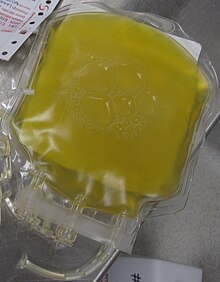Fresh frozen plasma

A bag containing one unit of fresh frozen plasma
|
|
| Clinical data | |
|---|---|
| AHFS/Drugs.com | Micromedex Detailed Consumer Information |
| Pregnancy category |
|
| ATC code | B05AX03 (WHO) |
| Identifiers | |
| Synonyms | plasma frozen within 24 hours after phlebotomy (FP24) |
Fresh frozen plasma (FFP) is a blood product made from the liquid portion of whole blood. It is used to treat conditions in which there are low blood clotting factors (INR>1.5) or low levels of other blood proteins. It is also used as part of plasma exchange. The specific batch typically needs to be tested for compatibility before it is given. Use as a volume expander is not recommended. It is given by injection into a vein.
Side effects include nausea and itchiness. Rarely there may be allergic reactions, blood clots, or infections. It is unclear if use during pregnancy or breastfeeding is safe for the baby. Greater care should be taken in people with protein S deficiency, IgA deficiency, or heart failure. Fresh frozen plasma is made up of a complex mixture of water, proteins, carbohydrates, fats, and vitamins. When frozen it lasts about a year.
Plasma first came into medical use during the Second World War. It is on the World Health Organization's List of Essential Medicines, the most effective and safe medicines needed in a health system. In the United Kingdom it costs about 30 pounds per unit. A number of other versions also exists including plasma frozen within 24 hours after phlebotomy, cryoprecipitate reduced plasma, and solvent detergent plasma.
...
Wikipedia
